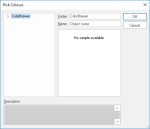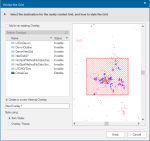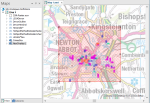Getis-Ord (Gi*) Hot Spot
Getis-Ord (Gi*) allows you to assemble a hot spot map based on statistical confidence. This kind of hot spot map is useful in crime analysis; it can be particularly efficient when querying small areas.
Getis-Ord hot spots can highlight significant clusters that are both hot and cold (i.e. areas with particularly high incidence and particularly low incidence). This is in stark contrast to KDE which can only highlight hot spots.
Select Analysis > Hot Spot > Getis-Ord.to start the Hot Spot wizard.
This is the first screen of the wizard. Use these options to specify grid dimensions.
| Option | Description | |
|
Cell Size |
Set the size of the Grid cells (in metres). For square grid cells, simply check the Regular tickbox. The Height value will be uneditable and equal to the Width value. If left unchecked, rectangular grid cells are created. Cell size is also known as the grid resolution (Resolution property) |
|
|
Origin |
To round the X and Y coordinates so they are multiples of cell width and height, check the Snap to cell size tickbox. With Automatic selected the origin of the Grid is set automatically based on the extents of the selected data. Specific makes the X and Y values editable, allowing you to manually specify the origin. |
|
|
Grid |
From the Form drop-down menu select your desired grid shape and the value type from the Values drop-down. |
|
Preview window
The preview updates instantaneously to show the Grid according to changing settings.
Click inside the preview window and hold down the middle scroll button to enable panning, click and roll the middle scroll button to zoom.
Note: Smaller Cell Size values create a higher resolution Grid but this may take longer to generate. This means progressing through the dialog may also take longer.
If the dialog stalls, the grid cell size may be too small. Go back to the Grid Creation dialog and alter the grid cell size.
After selecting the cell size and origin of the Grid click Next.
The next window allows you to create a grid from specified points.
Count
Check the Count tickbox to create the grid using a simple count of Point items.
Uncheck the Count tickbox to use the value of a property or expression:
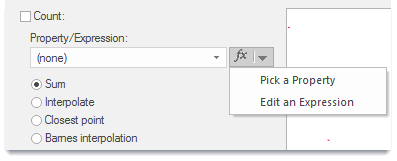
- Property/Expression: Press the fx button
 to display the Pick a Property or Expression Builder dialog. Select either the Property or Expression to be used.
to display the Pick a Property or Expression Builder dialog. Select either the Property or Expression to be used. - Sum: The item property values within each cell are added together and stored within the corresponding Grid cell.
- Interpolate: The Grid cell values are interpolated from surrounding Point items. This method could be used where the property gives a continuously varying measurement, such as height above sea level or polution levels.
- Closest point: The Grid cell value corresponds to the value of the closest point.
- Barnes interpolation: Constructs a grid of size determined by the distribution of the two dimensional data points. Using this grid, the function values are calculated at each grid point.
TIP: See Interpolation in SIS Desktop for a full description of the Interpolate and Closest point options.
Grid Values
Use No-Data values for zero values : Check this tickbox to treat Grid cells containing zero values as 'No-Data' and therefore making them hollow.
Click Next to move to the next screen.
Distance Method
Select the required distance measure from the drop-down menu.
a. Euclidean
As the crow flies, i.e a straight line.
Euclidean distance is calculated as D = sq root [(x1–x2)**2.0 + (y1–y2)**2.0]
where (x1, y1) is the coordinate for point A, (x2, y2) is the coordinate for point B, and D is the straight-line distance between points A and B.
b. Manhattan
Imitates moving across a city block: distances are traversed at right angles, ie the sum of the difference between the two point coordinates.
Spatial Relationship Conceptualization
- Fixed distance band: Every polygon within the distance threshold is counted as being ‘in’ and weighted 1, everything outside is counted as ‘out’ and weighted 0.
- Inverse distance: The weighting for features will decrease regularly with distance from the original centroid up to the distance threshold.
- Inverse distance squared: This is the same principle as Inverse distance but the weighting will decrease more severely with distance.
- K nearest neighbours: This will search for the K nearest centroids to the polygons centroid and use these as the Local Neighbourhood with weightings of 1, any others will be ignored (weighted 0).
- Zone of indifference: This is a combination of Fixed distance band and Inverse distance. Everything inside the threshold is ‘in’ and weighted 1, after this point the weighting tapers off towards 0.
Distance Band or Threshold Distance
The distance when performing the search for polygons in local neighbourhood; any polygons with centroids outside this distance are ignored when calculating local average value.
This option is only used when the Spatial Relationship Conceptualization parameter is set to Fixed distance band, Inverse distance, Inverse distance squared or Zone of indifference.
If no other centroids are found within this distance, the z-score and p-values for the polygon are not set.
A further column is created in the schema holding an error value.
Number of neighbours
The number of neighbours to factor in to the local average calculations when using the Spatial Relationship Conceptualization > K nearest neighbours parameter – will search for that many of the nearest centroids to the centroid of the polygon being calculated upon.
Spatial Statistic
Select the required spatial statistic:
z-score
This is the order of standard deviation displayed by the result.
A value further away from zero (either positive or negative) indicates a more intense clustering.
Negative Z-Scores indicate cold spots with low levels of incidence while positive z-scores indicate hot spots with high levels of incidence.
A z-score near zero indicates there is no concentration of values of either extreme, ie neighbouring areas have a mixture of high and low incidence.
p-value
This is the probability that the result has been created by random distribution ie the closer to 0 the p-value, the more confident you can be that the result is a genuine hot/cold spot and has not just obtained this extreme value by coincidence.
This corresponds to a confidence level, eg a p-value of 0.1 gives a 90% confidence value, meaning you can be 90% sure the result is not due to chance.
Click Next to move to the next window.
Set the Grid styles in this window.
Statistics
This section displays valuable Grid statistics including Minimum and Maximum cell values, the Average cell value and the Standard Deviation of cell values of the grid.
Colourset
Values
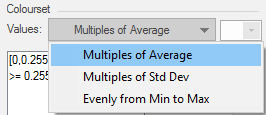
| Option | Description | |
|
Multiples of Average |
This option is automatically selected and sets the number of intervals according to the Grid cell Average. The range of each interval will equal the average. With this option the Values drop-down box will be unavailable. |
|
|
Multiples of Std Dev |
This option sets the number of intervals according to the Grid cell Standard Deviation. The range of each interval will equal the standard deviation. The Values drop-down box is unavailable for this option. |
|
|
Evenly from Min to Max |
Sets the intervals to equal sizes. The Values drop-down box becomes active to allow you to select the number of intervals. |
|
The next step is to choose individual colours (Pick Colour) or choose a colourset (Pick all Colours) to pick a
-
 Displays the standard Windows Color selection dialog to allow a basic or custom colour to be selected:
Displays the standard Windows Color selection dialog to allow a basic or custom colour to be selected: -
 This button is active when Evenly from Min to Max is selected and has values between 3 and 12.
This button is active when Evenly from Min to Max is selected and has values between 3 and 12.

Pressing the Pick all Colours button will display the Pick Colours dialog which provides a number of predefined coloursets.
ColorBrewer can be expanded to show the predefined coloursets. See the ColorBrewer topic .
If you have a range that does contain data but is at a low level that you do not want to be visible in the Grid you can select the range and set the value to fully transparent, for example:
Hue (range 0 to 240) this is the wavelength of the colour. This corresponds to a position in a rainbow of colours. The value changes the colours from red (at 0) to green to blue and back to red (at 240).
Saturation (range 0 to 240) this is the purity of the colour. For example, pink is an unsaturated form of red. Primary colours are saturated, pastel colours are unsaturated.
Luminosity (range 0 to 240) this is the brightness of the colour. Very dim colours become black.
Transparency (range 0 for fully opaque to 255 for fully transparent) this value sets the degree of transparency.
A quick way of creating a new colourset is by changing the colour of the first and last intervals, selecting all the intervals between and clicking Spread.

The Spread button gives the following options:
- Spread - spread colours and transparency
- Spread colours - spread colours only
- Spread transparency - spread transparency only
The first interval colour will be merged into the final interval colour across the selected intervals. The following image shows an example of this: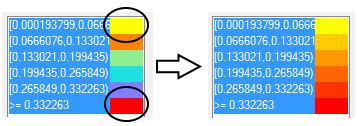
On completion of the Style the Grid dialog click Next.
The final step in this wizard is to review the grid.
This allows you to select where the Grid item will be created.
To store the grid item in an existing overlay, select the Overlay in the Add to an existing Overlay pane.
Remember this Overlay must have an Editable status and be able to store grid items.
Alternatively you can select Create in a new Internal Overlay, which will create the Grid item in a new overlay, in this case enter the name of the new overlay in the text box.
Style using
a. Item Styles
Select this option to style the grid using the colourset property previously selected in the Pick Colours dialog. The styling cannot be stored, however it can be changed by right clicking on the Grid and selecting Pick Colours.
b. Overlay Theme
Should a Relief Theme be added to the chosen Overlay?
A Relief Theme does not affect the Grid item itself. This Relief Theme is placed over the top of the Grid and can be turned on and off. The Relief Theme can be stored as either a new Theme or Colourset to be used again on another Grid. Once it has been created a Relief Theme cannot be edited. If the Relief Theme is turned off the Grid itself will be coloured according to the Overlay pen, with differing colour intensities showing changes across the Grid.
Whichever styling option is selected here, once the Grid is created the Grid Colourset can be changed to alter the colouring and the number of intervals.
This is accessed by selecting the Set Colourset option in the local menu, this displays the Style the Grid dialog (shown above).
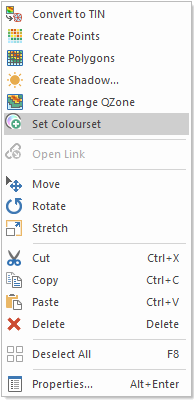
On completion of the Review the Grid dialog click Finish to create the Grid item.
TIP: We recommend initially running the analysis several times altering settings and styling so the created Grid is optimized for its purpose.
If the Grid is stored within an internal overlay, you can find it under 3D as Grid: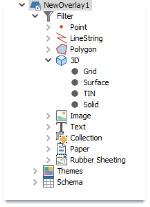

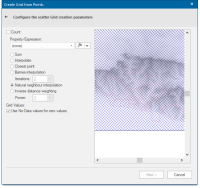
_thumb_150_0.png)
_thumb_150_0.png)
